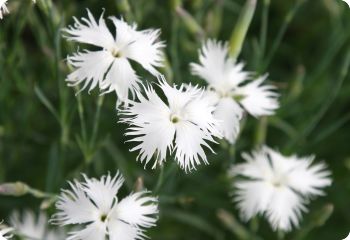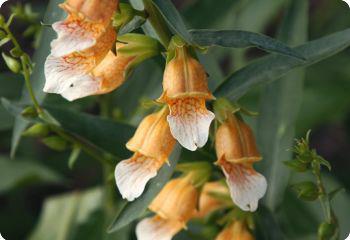Starting Seeds Indoors
by Diane Linsley
Starting seeds indoors is an exciting adventure. It may seem complicated at first, but once you learn the basics, it will soon become second nature.
Seed Starting Equipment
1. Seed flats. I like the plastic ones with separate cells.
2. Sterilized seed starting mix. Don't use regular potting soil, which is too coarse. Never use garden soil. Avoid peat pellets because they tend to stay soggy, which causes damping-off disease.
3. Mister (spray bottle) to moisten the soil while the seeds are germinating.
4. Rack to put the flats on. Rubbermaid makes a 4-tier storage rack with enough space between the shelves to let in the sunlight. You can attach grow lights, if necessary.
5. South or east-facing window. If you don't have enough sunlight, hang fluorescent tube lights 4" above the tops of the seedlings. Leave them on for up to 12-16 hours a day. Plants need darkness at night to rest from growing.
6. Fan. Good air circulation prevents damping-off disease.
7. Liquid fertilizer. I prefer a liquid organic fertilizer or Schultz brand liquid plant food. Miracle Grow is too strong for young seedlings, but it works fine for transplants in the garden.
Indoor Seed Starting Tips
1. Fill a flat with seedling mix, pressing it firmly into each cell. The mix will shrink when water is added.
2. Moisten the mix with warm water. Peat moss (the main ingredient) repels cold water. My flats require about one quart of water. Pour it slowly over the flat, trying not to wash out the soil. If the mix is already slightly moist, you can pour the water into the bottom of the tray, and it will wick up into the soil. Don't waterlog the soil. When the mix is moistened, lightly press it down to remove air pockets. Don't compact it too much.
3. Wait for half an hour for the mix to become evenly moist. If there's excess water in the bottom of the tray, pour it off.
4. Sow seeds 2 times as deep as they are wide. Tiny seeds like campanula are sown on the surface. Sow 5-8 seeds per cell, pressing them into the soil. Misting with water will help them settle in.
To sow larger seeds, poke a shallow hole in the soil. Sow 2-3 seeds per cell, then cover them with soil. The germination rate for most seeds is over 70%, but difficult perennials have a lower germination rate. That's why you need to sow more than one seed per cell. Avoid the temptation to sow dozens of tiny seeds into one cell. The seedlings won't thrive, and it will be a thinning nightmare. Save extra seeds to oversow any cells that don't germinate. If you have to oversow, replace the soil in the top half of the cell to remove any mold that might interfere with germination.
5. Place the clear plastic lid over the flat to retain humidity. Place the flat in a warm spot out of direct sunlight (like the top of the fridge). As soon as the seedlings appear, remove the lid, and move the flat to a window. Don't put the lid back on, or you may get damping-off disease.
6. If you started seeds that require pre-chilling, such as aquilegia or penstemon, place the flat in the fridge for the amount of time recommended on the packet. When the time is up, place the flat in a sunny window. The seedlings should appear in 3-6 weeks. The plastic lid retains heat, as well as humidity. So remove it when the sun is shining directly on the flat. The lid can be used at night, then permanently removed after the seeds sprout. Click here for stratifying seeds.
7. Sow extra seeds outdoors. Sometimes, the seeds sown outdoors grow better than the ones sown indoors. Of course, they have a lower germination rate because of environmental conditions.
Caring for Seedlings
1. Once the seedlings appear, set up a fan to circulate the air. This is the most important step for preventing damping-off disease. The fan will dry out the soil quickly, so check the moisture level twice a day.
2. When half of the cells are dry on top, and the flat feels light, it's time to water. Pour 1 quart of water into the bottom of the tray. Watering from the bottom up reduces the risk of damping-off disease. After a while, drain off any excess water. The cells in the corners dry out faster, so they should be watered more often. Avoid damaging tiny seedlings.
The most common cause of seedling death is overwatering. I give my seedlings enough water to keep them alive and growing, while allowing the soil to dry out on the surface between waterings.
3. After seedlings have developed their second set of leaves (the "true" leaves), start using liquid fertilizer. Follow the directions on the bottle. Don't over-fertilize, or the seedlings will be leggy.
4. Use a pair of manicure scissors to thin out extra seedlings. Don't pull them up, which could damage the roots of the other seedlings. Avoid thinning fragile seedlings like snapdragons until they are well established. Thin to 2 plants per cell at first. When they are larger, they can be thinned to the final plant. Some plants, like sweet alyssum, don't need much thinning. They are fine in groups.
Hardening Off and Transplanting Seedlings
1. When the weather is warm, start hardening off the seedlings. Set the rack outside on the east side of your house or in the dappled shade of a tree. Only do this for half an hour the first day. Watch the seedlings for signs of wilting, and don't put them out on cold or windy days. Slowly increase the time, until they are staying outside all day and coming in at night. During the hardening off phase, you may need to water more often to keep them from drying out.
2. Transplant the seedlings to the garden when all danger of frost is past. Water them daily until they are established. Add fertilizer or powdered seaweed to the first few waterings to encourage faster growth. Don't be tempted to transplant seedlings before the last frost date, no matter how nice the weather is. One year, I transplanted 100 seedlings a few days before my last frost date (May 15), and two days later the temperature dropped to freezing. I placed pots over as many seedlings as I could, but I still lost a lot.
3. Don't be discouraged if up to 10% of your seedlings die or get eaten by bugs. This can happen to anyone. If bugs are a serious problem, consider potting up the seedlings into 3" pots and growing them outside for a few more weeks before transplanting them. I've been known to dig up recently planted seedlings and repot them when I find them partially defoliated by insects.
4. Have fun!
Related Articles
Germinating Difficult Seeds - Nicking, soaking and stratifying seeds.
Self-Sowing Annuals - Flowers that reseed and come back every year.
First-Year Flowering Perennials - Plants that bloom the first year from seed.
Seeds

